Investigation on Hamburg Wheel-Tracking Device Stripping Performance Properties of Recycled Hot-Mix Asphalt Mixtures
Abstract
:1. Introduction
2. Materials and Methods
2.1. Materials
2.2. Binder Extraction and Determination of Binder Content
2.3. Physical Properties of the Virgin and Extracted Binders
2.4. Marshall Mixture Preparation
2.5. Mixture Preparation Containing RAP
2.6. Hamburg Wheel Tracking Test
3. Results and Discussion
3.1. Penetration, Softening Point, Ductility and Penetration Index
3.2. Marshall Properties of Control Mix and RAP Samples
3.3. Wheel Tracker Rutting Damage Results under Air Dry Mode
3.4. Wheel Tracker Moisture Damage Results under Wet Mode
4. Conclusions
- The addition of aged binder (extracted from RAP) causes a decline in the Penetration Index, indicating more brittleness and more susceptible to cracking. The Penetration Index of the virgin and binder containing 30%, 50% and 100% aged binder keeps on decreasing from 0.74 to 0.35.
- Viscosity of binder increased with addition of RAP percentages from 0.4 to 1.1 Pa∙s at 135 °C and from 0.10 to 0.34 Pa∙s at 160 °C, showing stiffness due to aging in the binder.
- Volumetric results showed that with mixtures with RAP content of more than 30%, careful consideration should be given to the asphalt binder grade to be added with recycled asphalt mixture in line with state specification designed by transportation authorities.
- Asphalt mixtures containing RAP performed well based on its Marshall stability properties. RAP with 100% utilization has showcased the stability of 22.89 kN as compared to the control mix stability of 12.69 kN.
- The Stripping performance is judged by stripping inflection point of the mixtures; the lower the stripping inflection point, the worse the stripping will be in the field. The stripping inflection point is at 10,000 passes for control mixtures, 13,200 for 30% RAP, 13,800 for 50% RAP and no stripping point is observed for 100% RAP.
Author Contributions
Funding
Conflicts of Interest
References
- Al-Qadi, I.L.; Elseifi, M.; Carpenter, S.H. Reclaimed Asphalt Pavement—A Literature Review; Illinois Center for Transportation: Chicago, IL, USA, 2007. [Google Scholar]
- Roberts, F.L.; Kandhal, P.S.; Brown, E.R.; Lee, D.-Y.; Kennedy, T.W. Hot Mix Asphalt Materials, Mixture Design and Construction; NAPA Research and Education Foundation: Lanham, MD, USA, 1991. [Google Scholar]
- Zaumanis, M.; Poulikakos, L.; Partl, M. Performance-based design of asphalt mixtures and review of key parameters. Mater. Des. 2018, 141, 185–201. [Google Scholar] [CrossRef]
- Adlinge, S.S.; Gupta, A. Pavement deterioration and its causes. Int. J. Innov. Res. Dev. 2013, 2, 437–450. [Google Scholar]
- Recycling, A.; Reclaiming Association-ARRA. Basic Asphalt Recycling Manual; Federal Highway Administration: Washington, DC, USA, 2001. [Google Scholar]
- Kuehl, R.; Korzilius, J.; Michael, M. Synopsis of Recycled Asphalt Pavement (RAP) Material; National Technical Information Services: Springfield, VA, USA, 2016; Volume 22161. [Google Scholar]
- Chiu, C.-T.; Hsu, T.-H.; Yang, W.-F. Life cycle assessment on using recycled materials for rehabilitating asphalt pavements. Resour. Conserv. Recycl. 2008, 52, 545–556. [Google Scholar] [CrossRef]
- Tao, M.; Mallick, R.B. Effects of warm-mix asphalt additives on workability and mechanical properties of reclaimed asphalt pavement material. Transp. Res. Rec. 2009, 2126, 151–160. [Google Scholar] [CrossRef]
- Lee, S.-H.; Tam, A.B.; Kim, J.; Park, D.-W. Evaluation of rejuvenators based on the healing and mechanistic performance of recycled asphalt mixture. Constr. Build. Mater. 2019, 220, 628–636. [Google Scholar] [CrossRef]
- Williams, B.A.; Willis, J.R.; Ross, T.C. Asphalt Pavement Industry Survey on Recycled Materials and Warm-Mix Asphalt Usage: 2018; NAPA: Greenbelt, MD, USA, 2019. [Google Scholar]
- West, R.C.; Willis, J.R.; Marasteanu, M.O. Improved Mix Design, Evaluation, and Materials Management Practices for Hot Mix Asphalt with High Reclaimed Asphalt Pavement Content; Transportation Research Board: Washington, DC, USA, 2013. [Google Scholar]
- Newcomb, D.E.; Brown, E.R.; Epps, J.A. Designing HMA Mixtures with High RAP Content: A practical Guide; National Asphalt Pavement Association: Greenbelt, MD, USA, 2007. [Google Scholar]
- Zaumanis, M.; Mallick, R.B.; Frank, R. 100% recycled hot mix asphalt: A review and analysis. Resour. Conserv. Recycl. 2014, 92, 230–245. [Google Scholar] [CrossRef]
- Zaumanis, M.; Mallick, R.B. Review of very high-content reclaimed asphalt use in plant-produced pavements: State of the art. Int. J. Pavement Eng. 2015, 16, 39–55. [Google Scholar] [CrossRef]
- Mohamady, A.; Elshahat, A.; Abd-Elmaksoud, M.F.; Abdallah, E.M.H. Effect of using reclaimed asphalt pavement on asphalt mix performance. IOSR J. Comput. Eng. (IOSR-JCE) 2014, 16, 55–67. [Google Scholar] [CrossRef]
- Leng, Z.; Sreeram, A.; Padhan, R.K.; Tan, Z. Value-added application of waste PET based additives in bituminous mixtures containing high percentage of reclaimed asphalt pavement (RAP). J. Clean. Product. 2018, 196, 615–625. [Google Scholar] [CrossRef]
- Daniel, J.S.; Lachance, A. Mechanistic and volumetric properties of asphalt mixtures with recycled asphalt pavement. Transp. Res. Rec. 2005, 1929, 28–36. [Google Scholar] [CrossRef]
- Arshad, A.; Karim, Z.A.; Shaffie, E.; Hashim, W.; Rahman, Z.A. Marshall properties and rutting resistance of hot mix asphalt with variable reclaimed asphalt pavement (RAP) content. In Materials Science and Engineering Conference Series; IOP Publishing: Bristol, UK, 2017; Volume 271, p. 012078. [Google Scholar]
- Sabhafer, N.; Hossain, M. Volumetric properties of Superpave mixtures with reclaimed asphalt pavement. In T&DI Congress 2014: Planes, Trains, and Automobiles; American Society of Civil Engineers: Reston, VA, USA, 2014; pp. 14–23. [Google Scholar]
- Faramarzi, M.; Lee, K.W.; Kim, Y.; Kwon, S. A case study on a cement treated RAP containing asphalt emulsion and acryl polymer. Case Stud. Constr. Mater. 2018, 9, e00211. [Google Scholar] [CrossRef]
- Van Winkle, C.I. Laboratory and Field Evaluation of Hot Mix Asphalt with High Contents of Reclaimed Asphalt Pavement. Master’s Thesis, University of Iowa, Iowa City, IA, USA, 2014. [Google Scholar]
- Xie, Z.; Rizvi, H.; Purdy, C.; Ali, A.; Mehta, Y. Effect of rejuvenator types and mixing procedures on volumetric properties of asphalt mixtures with 50% RAP. Constr. Build. Mater. 2019, 218, 457–464. [Google Scholar] [CrossRef]
- Monu, K.; Ransinchung, G.; Singh, S. Effect of long-term ageing on properties of RAP inclusive WMA mixes. Constr. Build. Mater. 2019, 206, 483–493. [Google Scholar] [CrossRef]
- Cooper, S.B., Jr.; Mohammad, L.N.; Elseifi, M.A. Laboratory performance of asphalt mixtures containing recycled asphalt shingles, reclaimed asphalt pavement, and recycling agent. J. Mater. Civil Eng. 2017, 29. [Google Scholar] [CrossRef]
- Khan, K.M.; Kamal, M.A. Impact of superpave mix design method on rutting behavior of flexible pavements in Pakistan. Arab. J. Sci. Eng. 2008, 33, 379–390. [Google Scholar]
- Frigio, F.; Canestrari, F. Characterisation of warm recycled porous asphalt mixtures prepared with different WMA additives. Eur. J. Environ. Civ. Eng. 2018, 22, 82–98. [Google Scholar] [CrossRef]
- Tavakol, M. Minimum Virgin Binder Limits in Recycled Superpave (SR) Mixes in Kansas; Kansas State University: Manhattan, KS, USA, 2016. [Google Scholar]
- AASHTO T 324. Standard Method of Test for Hamburg Wheel-Track Testing of Compacted Hot Mix Asphalt (HMA); AASHTO: Washington, DC, USA, 2011. [Google Scholar]
- Cox, J.A.; VanFrank, K.; Romero, P. On the variability of results from the Hamburg wheel tracker device. In Proceedings of the 49th ASC Annual International Conference, San Luis Obispo, CA, USA, 10–13 April 2013. [Google Scholar]
- Du, Y.; Chen, J.; Han, Z.; Liu, W. A review on solutions for improving rutting resistance of asphalt pavement and test methods. Constr. Build. Mater. 2018, 168, 893–905. [Google Scholar] [CrossRef]
- Fakhri, M.; Hosseini, S.A. Laboratory evaluation of rutting and moisture damage resistance of glass fiber modified warm mix asphalt incorporating high RAP proportion. Constr. Build. Mater. 2017, 134, 626–640. [Google Scholar] [CrossRef]
- Cooley, L.A.; Kandhal, P.S.; Buchanan, M.S.; Fee, F.; Epps, A. Loaded Wheel Testers in the United States: State of the Practice; Transportation Research Board: Washington, DC, USA; National Research Council: Washington, DC, USA, 2000. [Google Scholar]
- Yildirim, Y.; Jayawickrama, P.W.; Hossain, M.S.; Alhabshi, A.; Yildirim, C.; Smit, A.D.F.; Little, D. Hamburg Wheel-Tracking Database Analysis; FHWA/TX-05/01–7077–; Texas Department of Transportation and Federal Highway Administration: Austin, TX, USA, 2007.
- Rahman, F.; Hossain, M. Review and Analysis of Hamburg Wheel Tracking Device Test Data; Kansas Department of Transportation, Bureau of Materials & Research: Topeka, KS, USA, 2014.
- Xiao, F.; Li, R.; Amirkhanian, S.; Yuan, J. Rutting-resistance investigation of alternative polymerized asphalt mixtures. J. Mater. Civil Eng. 2018, 30, 04018116. [Google Scholar] [CrossRef]
- Fakhri, M.; Maleki, H.; Hosseini, S.A. Investigation of different test methods to quantify rutting resistance and moisture damage of GFM-WMA mixtures. Constr. Build. Mater. 2017, 152, 1027–1040. [Google Scholar] [CrossRef]
- Fakhri, M.; Azami, A. Evaluation of warm mix asphalt mixtures containing reclaimed asphalt pavement and crumb rubber. J. Clean. Product. 2017, 165, 1125–1132. [Google Scholar]
- Park, D.-W.; Seo, W.-J.; Kim, J.; Vo, H.V. Evaluation of moisture susceptibility of asphalt mixture using liquid anti-stripping agents. Constr. Build. Mater. 2017, 144, 399–405. [Google Scholar] [CrossRef]
- Izzo, R.P. Evaluation of the Use of the Hamburg Wheel-Tracking Device for Moisture Susceptibility of Hot Mix Asphalt; Texas Department of Transportation, Construction Division/Bituminous Branch: Austin, TX, USA, 1998.
- Kennedy, T.; McGennis, R.; Roberts, F. Investigation of moisture damage to asphalt concrete and the effect on field performance—A case study. Transp. Res. Rec. 1983, 911, 158–165. [Google Scholar]
- Raya, J.K. Standard Specification for Road Works; JKR/SPJ/rev2005; JKR: Kuala Lumpur, Malaysia, 2005. [Google Scholar]
- Manolis, S. Asphalt Extraction and Recovery Procedures an Introduction; Coco Asphalt Engineering: Bath, ON, Canada, 2017; p. 64. [Google Scholar]
- AASHTO. A. Standard T27. Sieve Analysis of Fine and Coarse Aggregates; American Association of State Highway and Transportation Officials: Washington, DC, USA, 2008. [Google Scholar]
- ASTM International. Standard Test Method for Penetration of Bituminous Materials; ASTM International: West Conshohocken, PA, USA, 2013. [Google Scholar]
- ASTM International. Standard Test Method for Softening Point of Bitumen (Ring-and-Ball Apparatus); ASTM International: West Conshohocken, PA, USA, 2014. [Google Scholar]
- ASTM International. Standard Test Method for Viscosity Determination of Asphalt at Elevated Temperatures Using a Rotational Viscometer; American Society for Testing and Materials: West Conshohocken, PA, USA, 2015. [Google Scholar]
- Dony, A.; Colin, J.; Bruneau, D.; Drouadaine, I.; Navaro, J. Reclaimed asphalt concretes with high recycling rates: Changes in reclaimed binder properties according to rejuvenating agent. Constr. Build. Mater. 2013, 41, 175–181. [Google Scholar] [CrossRef]
- Amani, M.J.; Gray, M.R.; Shaw, J.M. The phase behavior of Athabasca bitumen + toluene + water ternary mixtures. Fluid Phase Equilibria 2014, 370, 75–84. [Google Scholar] [CrossRef]
- Fadaei, H.; Shaw, J.M.; Sinton, D. Bitumen–toluene mutual diffusion coefficients using microfluidics. Energy Fuels 2013, 27, 2042–2048. [Google Scholar] [CrossRef]
- Hussein, Z.; Yaacob, H.; Idham, M.; Hassan, N.; Choy, L.; Jaya, R. Restoration of aged bitumen properties using maltenes. In IOP Conference Series: Materials Science and Engineering; IOP Publishing: Bristol, UK, 2020; Volume 713, p. 012014. [Google Scholar]
- Hunter, R.N.; Self, A.; Read, J. The Shell Bitumen Handbook; ICE Publishing: London, UK, 2015. [Google Scholar]
- Chen, J.-S.; Liao, M.-C.; Lin, C.-H. Determination of polymer content in modified bitumen. Mater. Struct. 2003, 36, 594–598. [Google Scholar] [CrossRef]
- Hussain, A.; Yanjun, Q. Effect of reclaimed asphalt pavement on the properties of asphalt binders. Procedia Eng. 2013, 54, 840–850. [Google Scholar] [CrossRef] [Green Version]
- Noferini, L.; Simone, A.; Sangiorgi, C.; Mazzotta, F. Investigation on performances of asphalt mixtures made with reclaimed asphalt pavement: Effects of interaction between virgin and RAP bitumen. Int. J. Pavement Res. Technol. 2017, 10, 322–332. [Google Scholar] [CrossRef]
- Ekblad, J.; Lundström, R. Soft bitumen asphalt produced using RAP. Mater. Struct. 2017, 50, 13. [Google Scholar] [CrossRef] [Green Version]
- Ahmad, J.; Rahman, M.; Din, K. Degradation and abrasion of reclaimed asphalt pavement aggregates. Int. J. Eng. Technol. 2004, 1, 139–145. [Google Scholar]
- Copeland, A. Reclaimed Asphalt Pavement in Asphalt Mixtures: State of the Practice; Federal Highway Administration, Office of Research Development, and Technology: Baltimore, MD, USA, 2011. [Google Scholar]
- Yousefi Rad, F. Estimating Blending Level of Fresh and RAP Binders in Recycled Hot Mix Asphalt. Ph.D. Thesis, College of Engineering, University of Wisconsin, Madison, WI, USA, 2013. [Google Scholar]
- Yildirim, Y.; Kennedy, T.W. Correlation of Field Performance to Hamburg Wheel Tracking Device Results; Center for Transportation Research, Bureau of Engineering Research, The University of Texas: Austin, TX, USA, 2001. [Google Scholar]
- Izzo, R.P.; Tahmoressi, M. Use of the Hamburg wheel-tracking device for evaluating moisture susceptibility of hot-mix asphalt. Transp. Res. Rec. 1999, 1681, 76–85. [Google Scholar] [CrossRef]
- Aschenbrener, T.; Currier, G. Influence of Testing Variables on the Results from the Hamburg Wheel-Tracking Device; Final Report; Colorado Department of Transportation: Denver, CO, USA, 1993.
- Aschenbrener, T.; Terrel, R.; Zamora, R. Comparison of the Hamburg Wheel-Tracking Device and the Environmental Conditioning System to Pavements of Known Stripping Performance; Final Report; Colorado Department of Transportation: Denver, CO, USA, 1994.

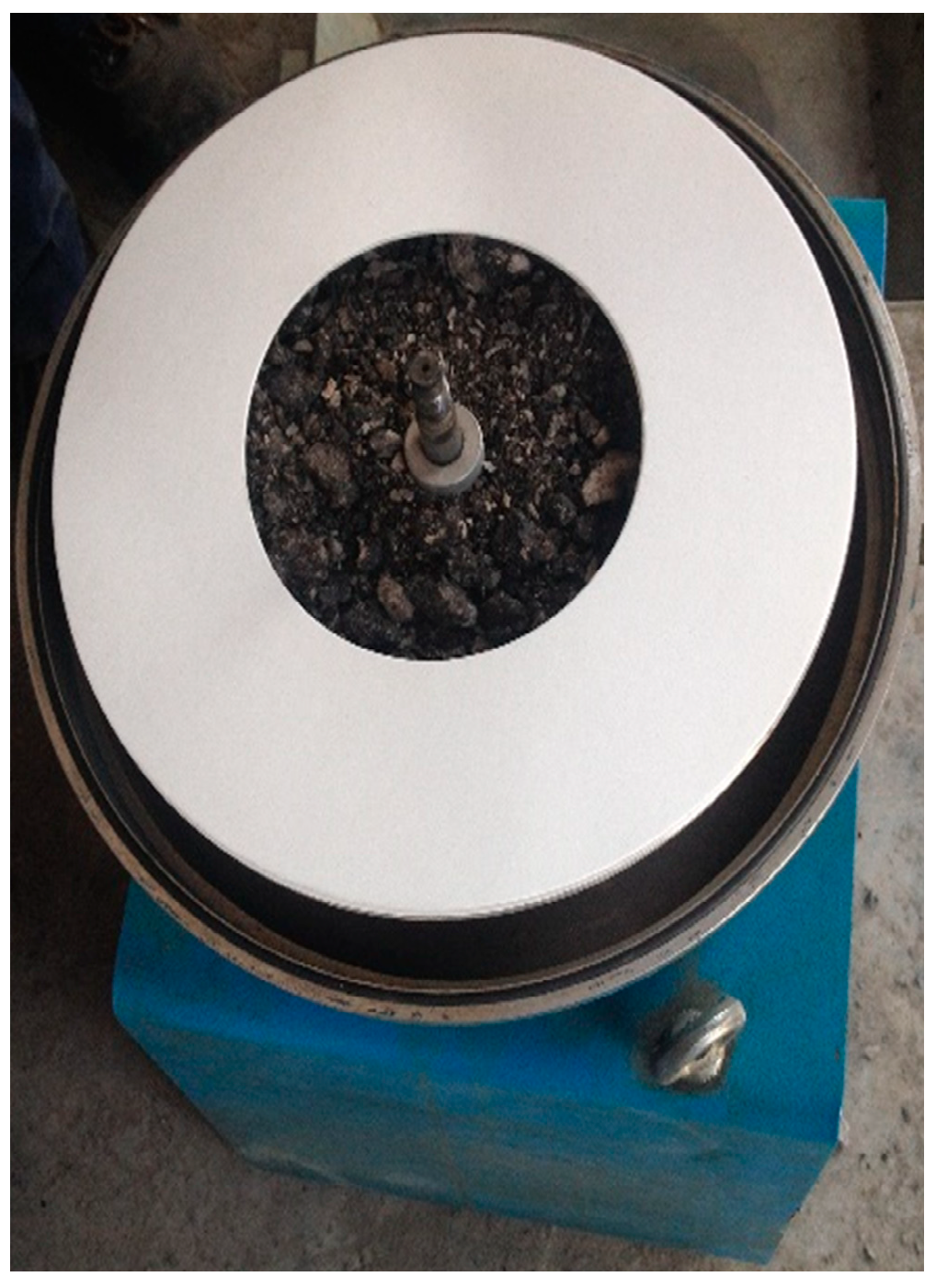
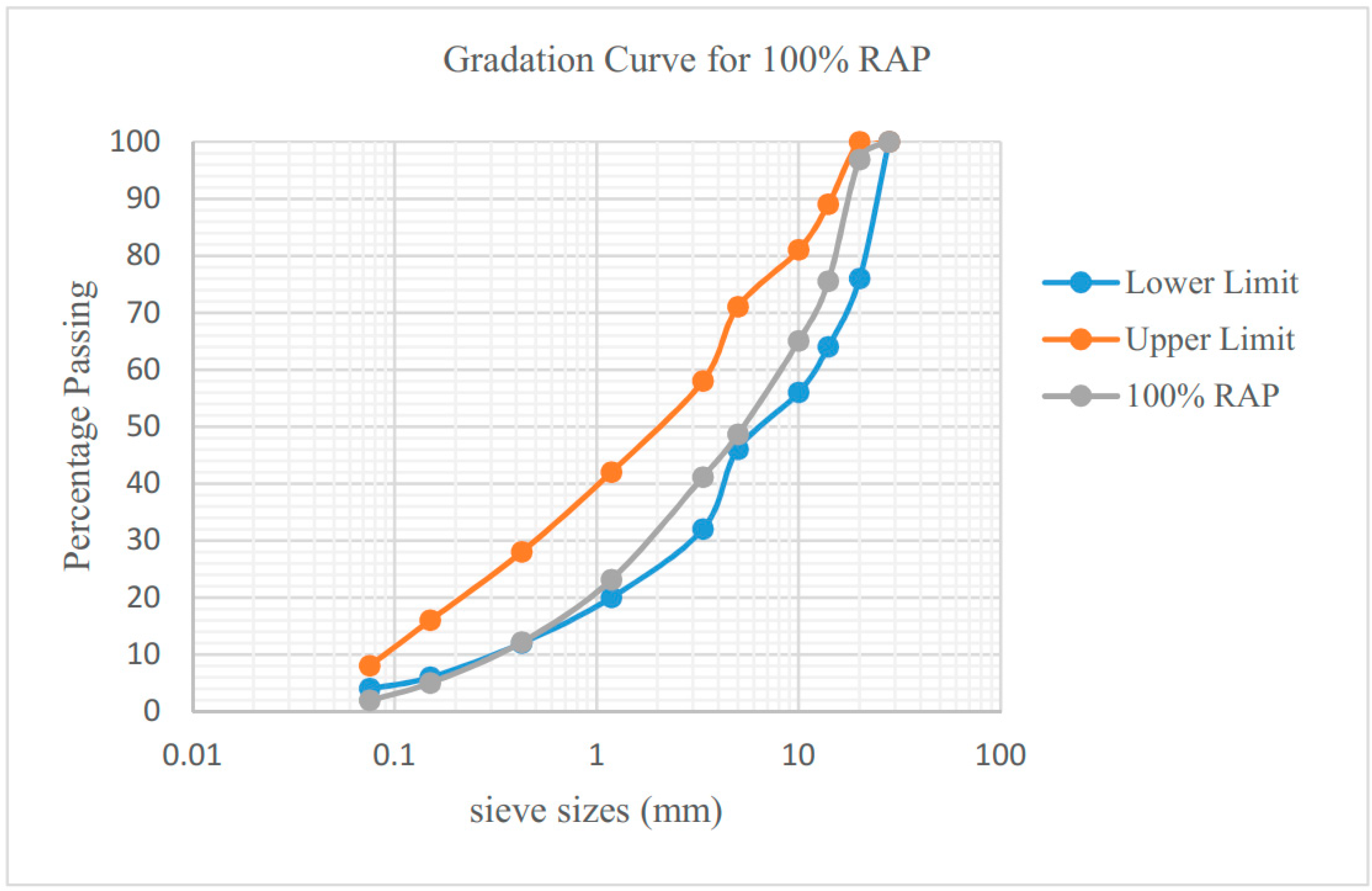
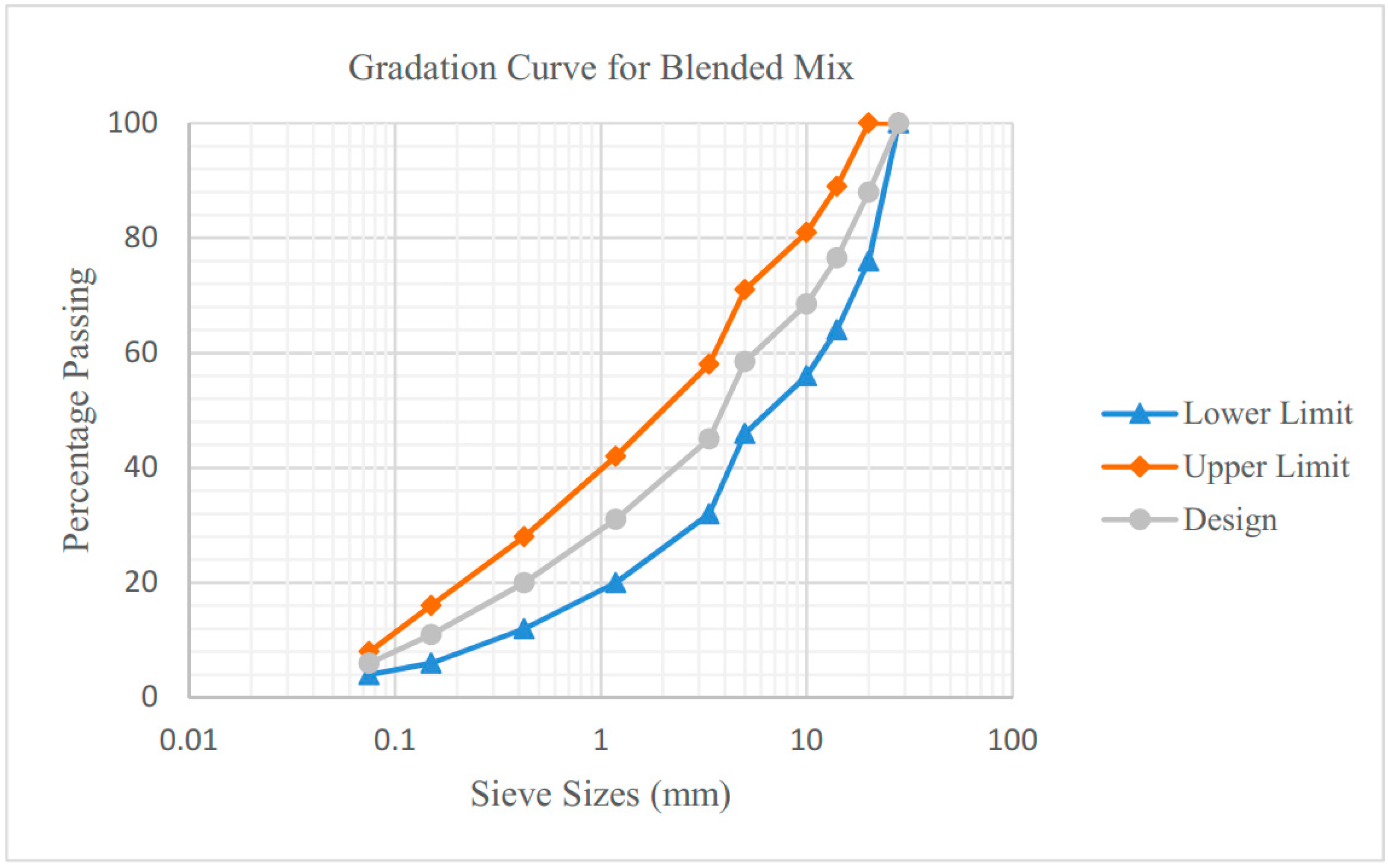
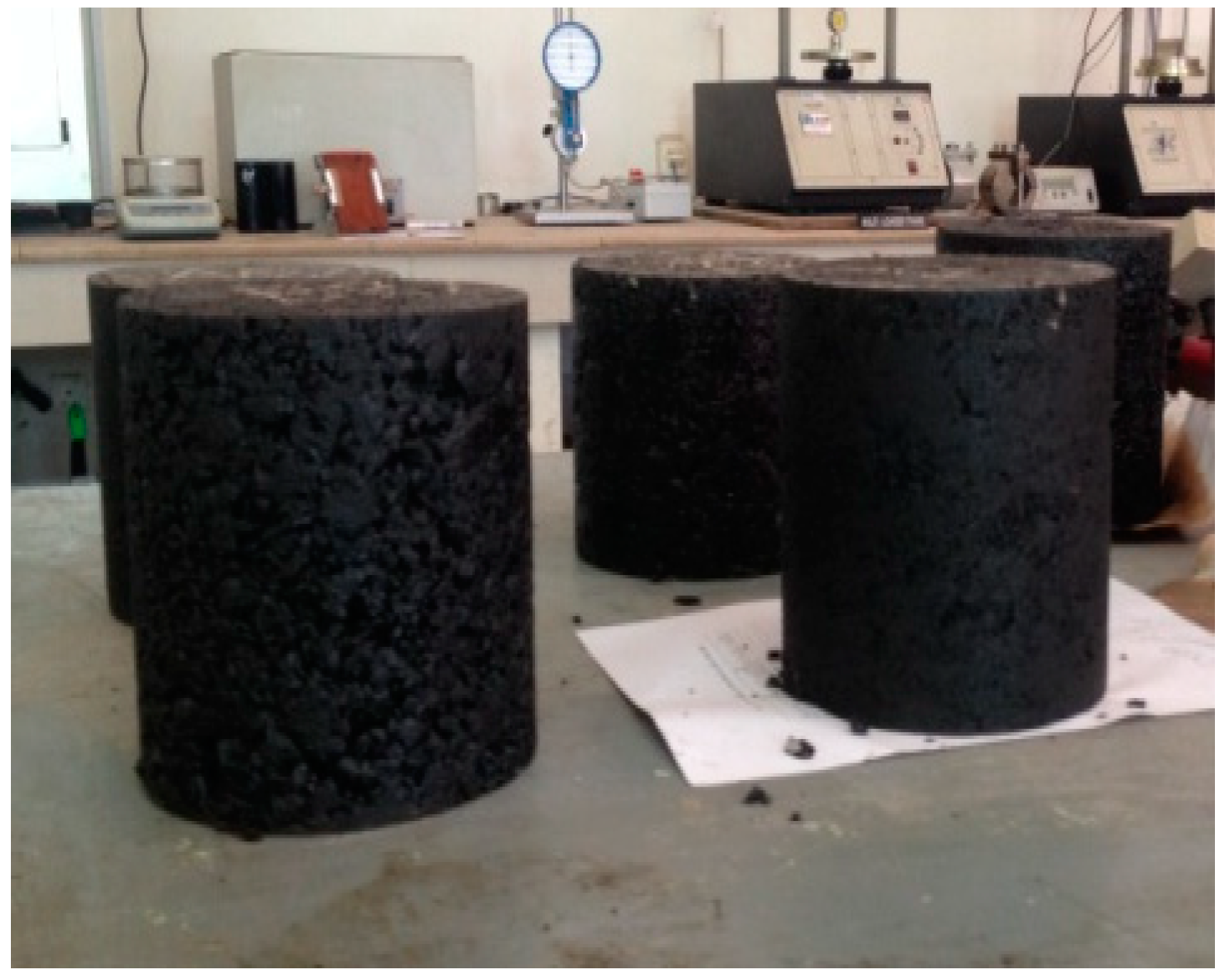
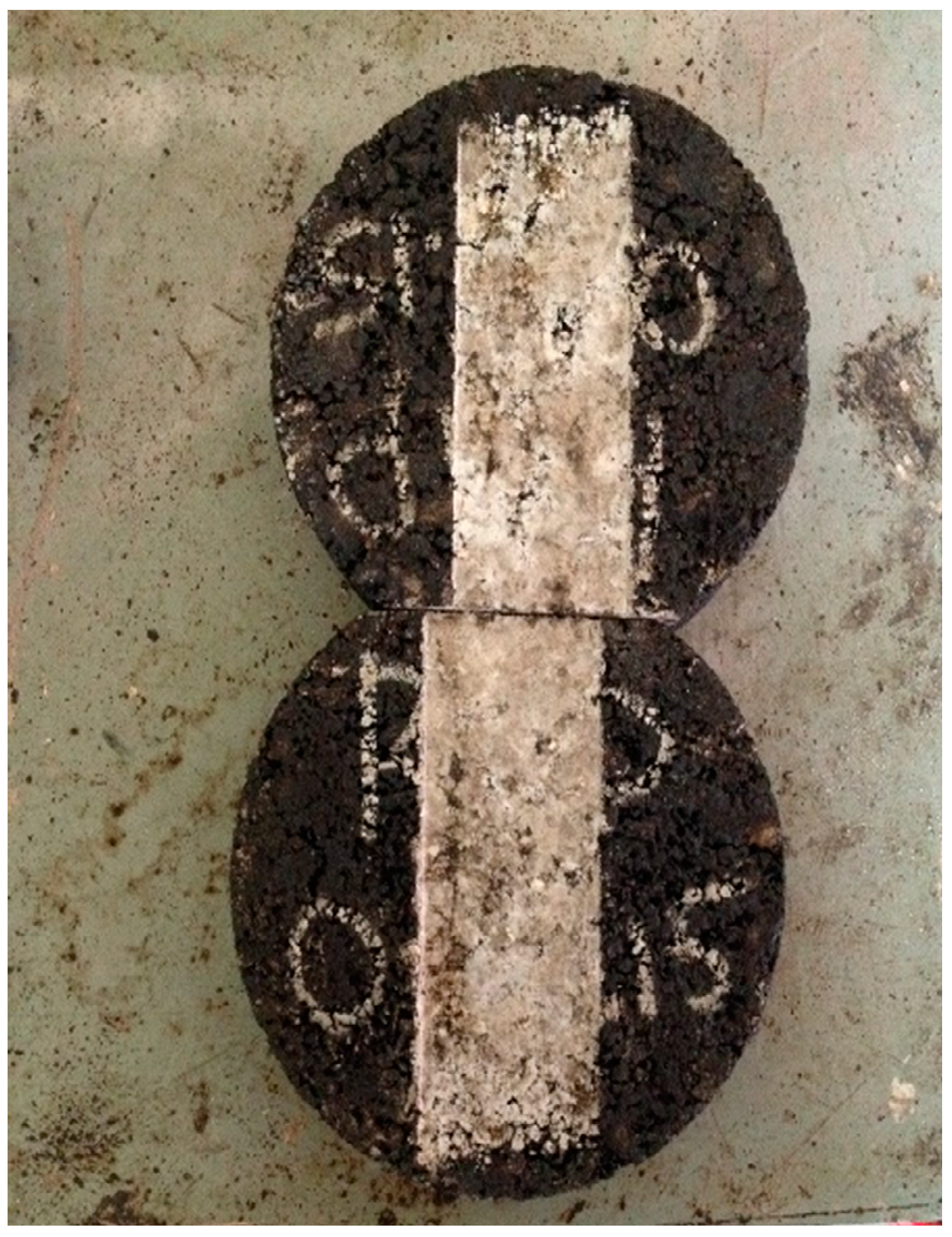
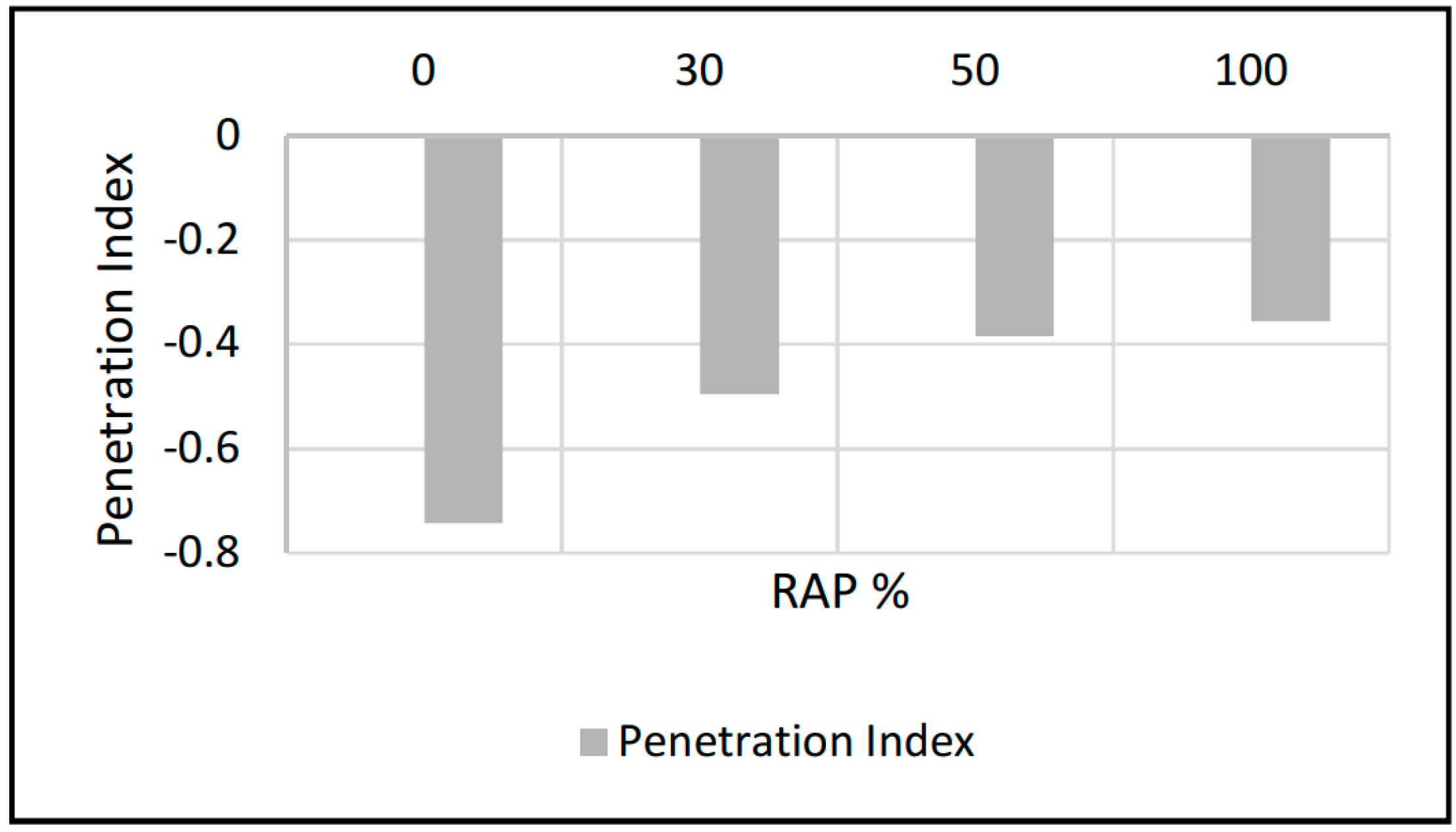
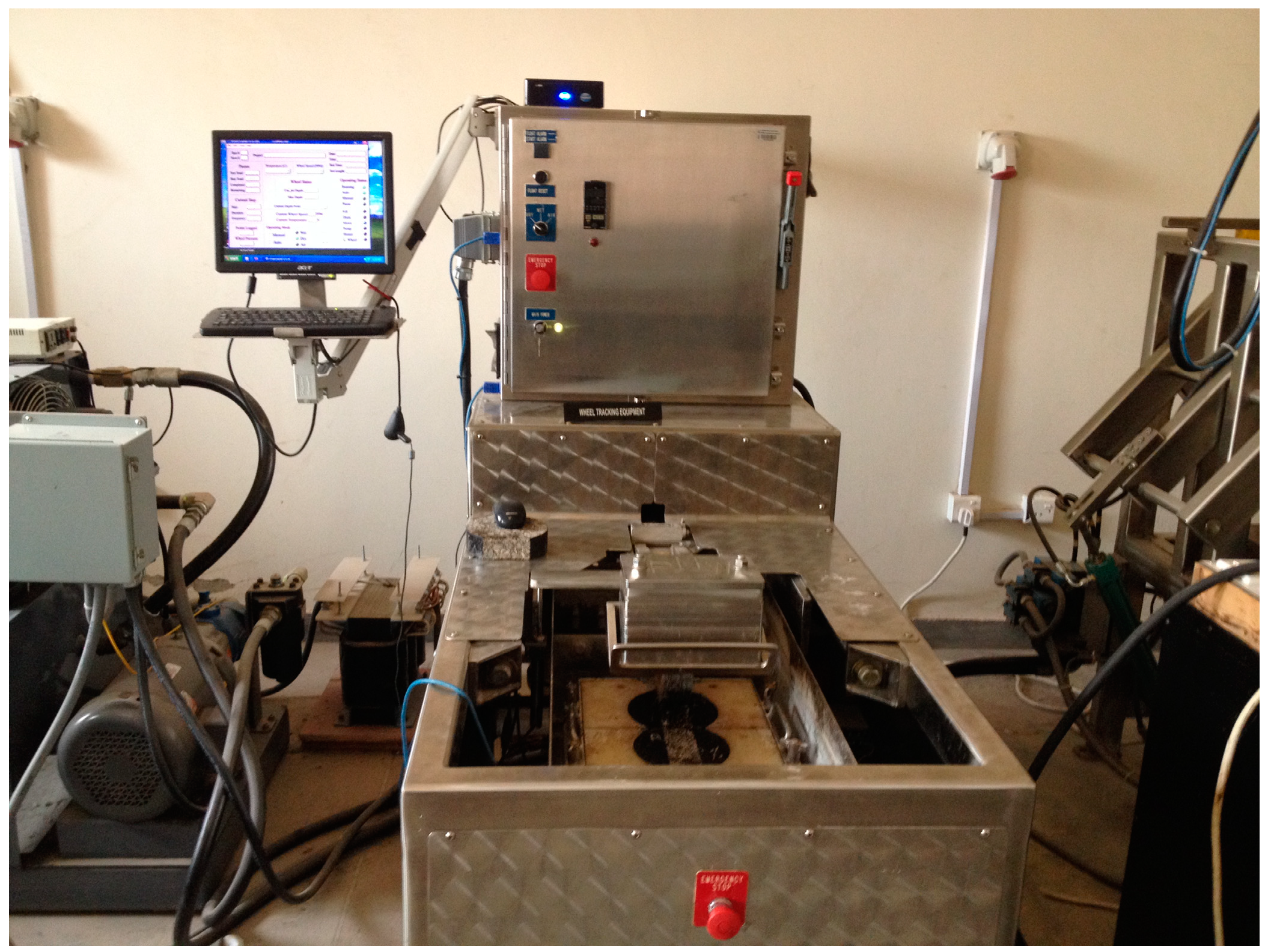

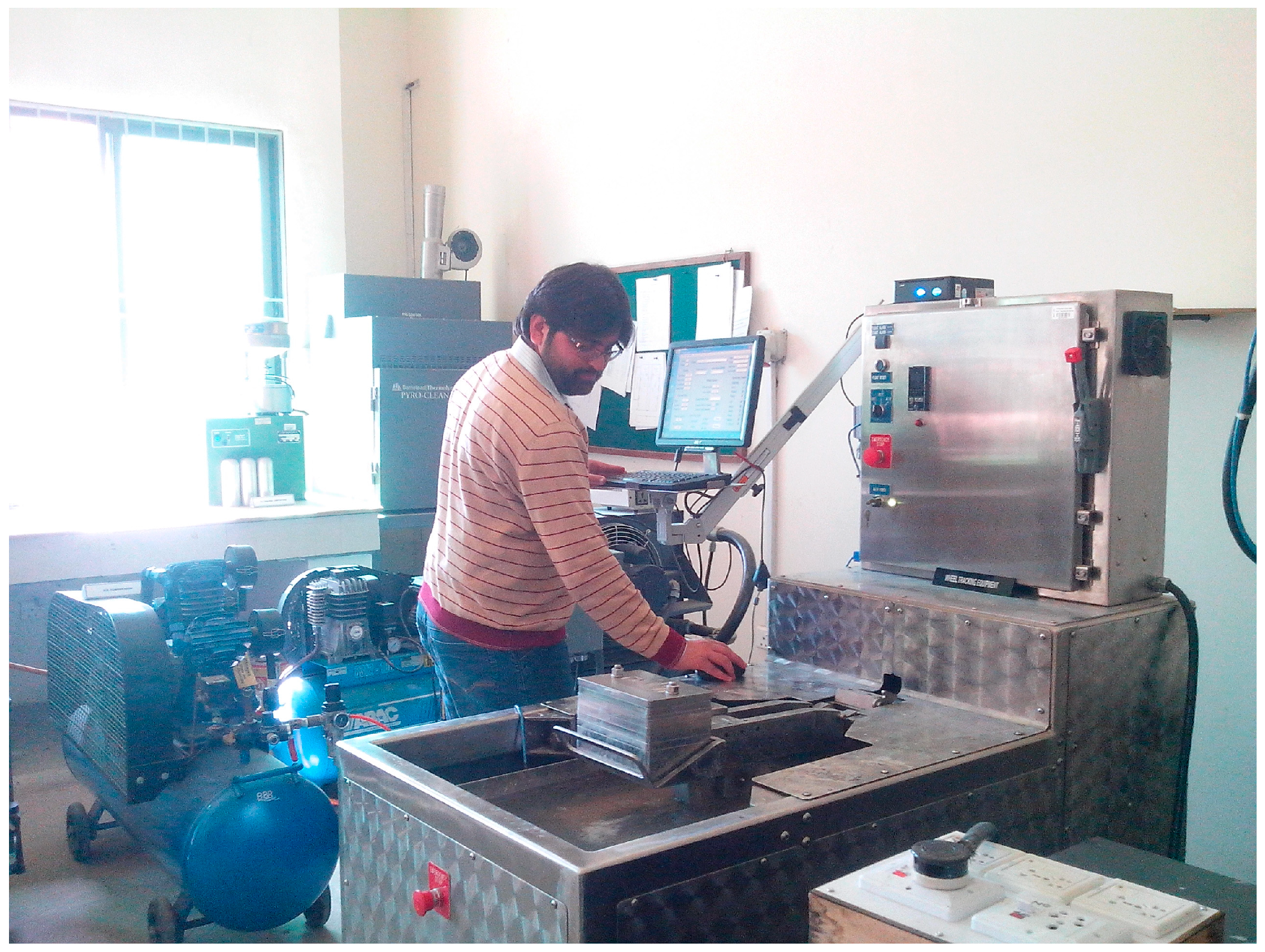
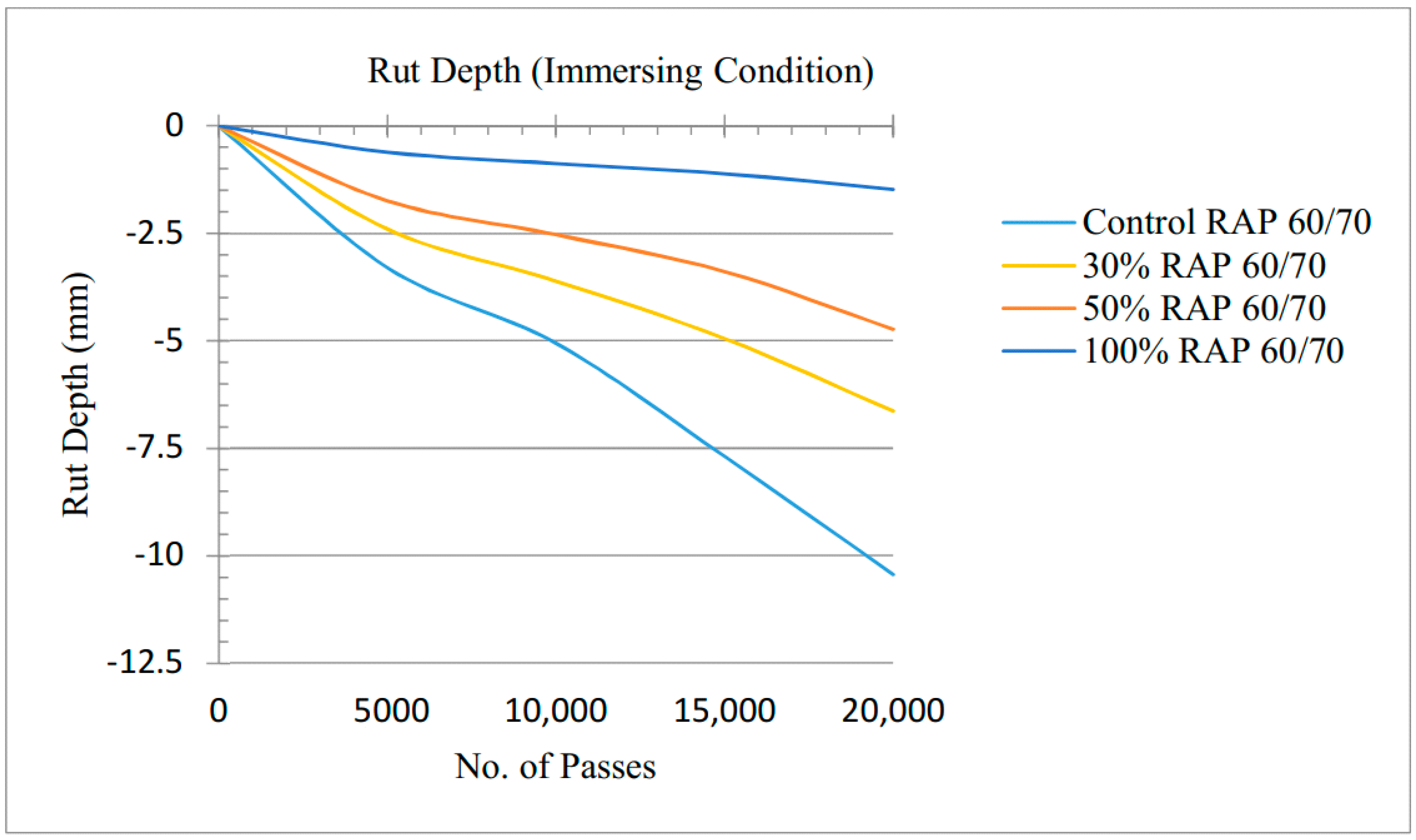
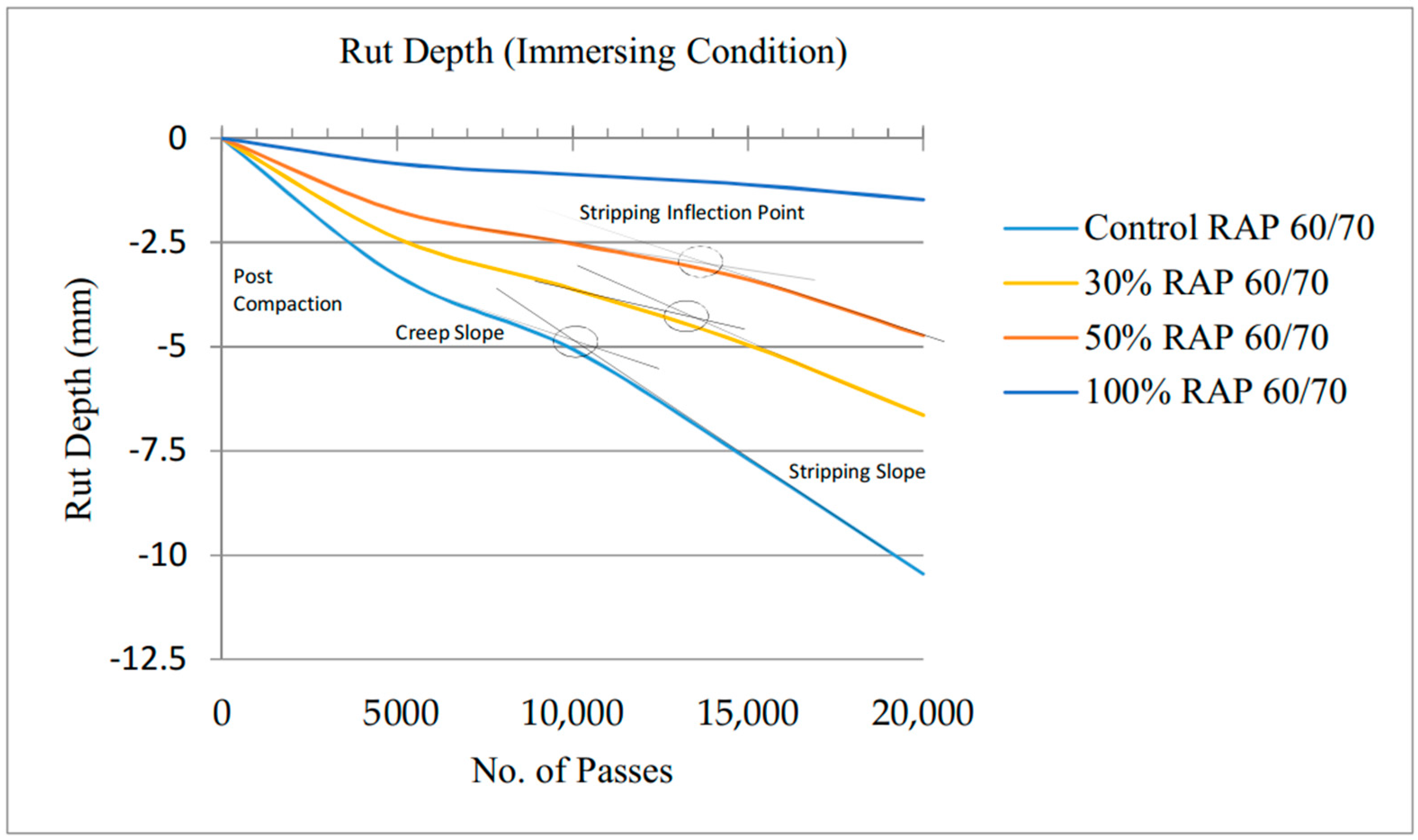
| Mix Designation | Type 2 |
|---|---|
| BS Sieve Size (mm) | Percentage Passing by Weight |
| 28 | 100 |
| 20 | 76–100 |
| 14 | 64–89 |
| 10 | 56–81 |
| 5 | 46–71 |
| 3.350 | 32–58 |
| 1.180 | 20–42 |
| 0.425 | 12–28 |
| 0.150 | 6–16 |
| 0.075 | 4–8 |
| Bitumen Content | BUW | VIM (%) | VMA (%) | VFB (%) | S (kN) | F (mm) |
|---|---|---|---|---|---|---|
| 4.0 | 2.408 | 4.09 | 14.82 | 63.10 | 16.49 | 2.74 |
| 4.5 | 2.418 | 3.90 | 14.92 | 70.80 | 17.10 | 3.23 |
| 5.0 | 2.424 | 3.39 | 15.16 | 77.63 | 14.83 | 3.43 |
| 5.5 | 2.427 | 3.20 | 15.49 | 83.68 | 12.10 | 3.31 |
| 6.0 | 2.424 | 3.03 | 16.03 | 88.12 | 9.45 | 3.11 |
| Sieve Size (mm) | Average RAP | % Retained | % Passing | RAP/HMA Mass Retained (g) | |||||||
|---|---|---|---|---|---|---|---|---|---|---|---|
| 100/0 | 50/50 | 30/70 | 0/100 | ||||||||
| 100 | 0 | 50 | 50 | 30 | 70 | 0 | 100 | ||||
| 28 | - | 100 | 0 | - | - | - | - | - | - | - | - |
| 20 | 14.93 | 3.13 | 96.87 | 37.61 | 0.00 | 18.80 | 18.80 | 11.28 | 26.33 | 0.00 | 37.61 |
| 14 | 101.97 | 21.40 | 75.47 | 256.79 | 0.00 | 128.39 | 128.39 | 77.04 | 179.75 | 0.00 | 256.79 |
| 10 | 49.70 | 10.43 | 65.04 | 125.16 | 0.00 | 62.58 | 62.58 | 37.55 | 87.61 | 0.00 | 125.16 |
| 5 | 78.17 | 16.40 | 48.63 | 196.85 | 0.00 | 98.43 | 98.43 | 59.06 | 137.80 | 0.00 | 196.85 |
| 3.350 | 35.67 | 7.49 | 41.15 | 89.82 | 0.00 | 44.91 | 44.91 | 26.95 | 62.88 | 0.00 | 89.82 |
| 1.180 | 85.80 | 18.01 | 23.14 | 216.08 | 0.00 | 108.04 | 108.04 | 64.82 | 151.25 | 0.00 | 216.08 |
| 0.425 | 52.40 | 11.00 | 12.14 | 131.96 | 0.00 | 65.98 | 65.98 | 39.59 | 92.37 | 0.00 | 131.96 |
| 0.150 | 34.03 | 7.14 | 5.00 | 85.71 | 0.00 | 42.85 | 42.85 | 25.71 | 60.00 | 0.00 | 85.71 |
| 0.075 | 14.50 | 3.04 | 1.96 | 36.52 | 0.00 | 18.26 | 18.26 | 10.95 | 25.56 | 0.00 | 36.52 |
| Pan | 9.33 | 1.96 | 0.00 | 23.50 | 0.00 | 11.75 | 11.75 | 7.05 | 16.45 | 0.00 | 23.50 |
| RAP/Virgin Ratio | Penetration | Softening Point (°C) | Ductility (cm) | Penetration Index | Viscosity at 135 °C Pa∙s | Viscosity at 160 °C Pa∙s |
|---|---|---|---|---|---|---|
| 0/100 | 64 | 49.5 | 117 | −0.743 | 0.40 | 0.10 |
| 30/70 | 45 | 54 | 89 | −0.496 | 0.50 | 0.20 |
| 50/50 | 42 | 56 | 76 | −0.385 | 0.60 | 0.24 |
| 100/0 | 22 | 62 | 17 | −0.355 | 1.10 | 0.34 |
| Properties | Control Mix | RAP 30 | RAP 50 | RAP 100 | JKR Specifications |
|---|---|---|---|---|---|
| OBC (%) | 5.00 | 5.00 | 5.00 | 5.00 | - |
| BUW | 2.424 | 2.373 | 2.392 | 2.405 | - |
| Std | 0.02 | 0.03 | 0.03 | 0.03 | - |
| VIM (%) | 3.39 | 4.5 | 4.3 | 4.14 | 3.0–5.0% |
| Std | 0.12 | 0.3 | 0.25 | 0.26 | - |
| VMA | 15.16 | 16.93 | 17.03 | 15.82 | - |
| Std | 0.43 | 0.66 | 0.56 | 0.64 | - |
| VFB (%) | 77.63 | 68.08 | 67.55 | 73.83 | 70–80% |
| Std | 1.10 | 1.15 | 1.39 | 1.10 | - |
| Stability (kN) | 12.69 | 14.83 | 17.48 | 22.89 | >8 kN |
| Std | 1.15 | 1.23 | 1.09 | 1.53 | - |
| Flow, F (mm) | 3.34 | 3.43 | 3.51 | 3.77 | 2.0–4.0 mm |
| Std | 0.31 | 0.51 | 0.36 | 0.46 | - |
Publisher’s Note: MDPI stays neutral with regard to jurisdictional claims in published maps and institutional affiliations. |
© 2020 by the authors. Licensee MDPI, Basel, Switzerland. This article is an open access article distributed under the terms and conditions of the Creative Commons Attribution (CC BY) license (http://creativecommons.org/licenses/by/4.0/).
Share and Cite
Rafiq, W.; Bin Napiah, M.; Hartadi Sutanto, M.; Salah Alaloul, W.; Nadia Binti Zabri, Z.; Imran Khan, M.; Ali Musarat, M. Investigation on Hamburg Wheel-Tracking Device Stripping Performance Properties of Recycled Hot-Mix Asphalt Mixtures. Materials 2020, 13, 4704. https://doi.org/10.3390/ma13214704
Rafiq W, Bin Napiah M, Hartadi Sutanto M, Salah Alaloul W, Nadia Binti Zabri Z, Imran Khan M, Ali Musarat M. Investigation on Hamburg Wheel-Tracking Device Stripping Performance Properties of Recycled Hot-Mix Asphalt Mixtures. Materials. 2020; 13(21):4704. https://doi.org/10.3390/ma13214704
Chicago/Turabian StyleRafiq, Waqas, Madzlan Bin Napiah, Muslich Hartadi Sutanto, Wesam Salah Alaloul, Zarisha Nadia Binti Zabri, Muhammad Imran Khan, and Muhammad Ali Musarat. 2020. "Investigation on Hamburg Wheel-Tracking Device Stripping Performance Properties of Recycled Hot-Mix Asphalt Mixtures" Materials 13, no. 21: 4704. https://doi.org/10.3390/ma13214704





